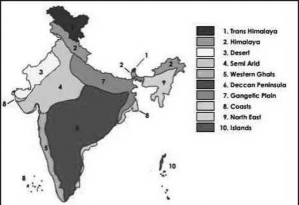b) Biomes of India:
The term biome means the main groups of plants and animals living in areas of certain climate patterns. It includes the way in which animals, vegetation and soil interact together. The plants and animals living in the area are adapted to that environment. The five biomes of India are:
1) Tropical Humid Forests
2) Tropical Dry or Deciduous Forests (including Monsoon Forests)
3) Warm deserts and semi-deserts
4) Coniferous forests and
5) Alpine meadows.
c) Bio-geographic Zones:

Bio-geographic Zones India
Biogeography deals with the geographical distribution of plants and animals. There are 10 biogeographic zones which are distinguished clearly in India. They are as follows—
1) Trans-Himalayas. An extension of the Tibetan plateau, harboring high-altitude cold desert in Laddakh (J&K) and Lahaul Spiti (H.P) comprising 5.7 % of the country’s landmass.
2) Himalayas. The entire mountain chain running from north-western to northeastern India, comprising a diverse range of biotic provinces and biomes, 7.2 % of the country’s landmass.
3) Desert. The extremely arid area west of the Aravalli hill range, comprising both the salty desert of Gujarat and the sand desert of Rajasthan. 6.9% of the country’s landmass.
4) Semi-arid. The zone between the desert and the Deccan plateau, including the Aravalli hill range. 15.6
% of the country’s landmass.
5) Western ghats. The hill ranges and plains running along the western coastline, south of the Tapti river, covering an extremely diverse range of biotic provinces and biomes. 5.8% of the country’s landmass.
6) Deccan peninsula. The largest of the zones, covering much of the southern and southcentral plateau with a predominantly deciduous vegetation. 4.3 % of the country’s landmass.
7) Gangetic plain. Defined by the Ganges river system, these plains are relatively homogenous. 11% of the country’s landmass.
8) North-east India. The plains and non-Himalayan hill ranges of northeastern India, with a wide variation of vegetation. 5.2% of the country’s landmass.
9) Islands. The Andaman and Nicobar Islands in the Bay of Bengal, with a highly diverse set of biomes. 0.03% of the country’s landmass.
10) Coasts. A large coastline distributed both to the west and east, with distinct differences between the two; Lakshadeep islands are included in this with the percent area being negligible.
Biogeography is divided into branches:
i. Phyto-geography (plant geography) deals with origin, distribution and environmental interrelationships
of plants.
ii. Zoogeography deals with the migration and distribution of animals.
